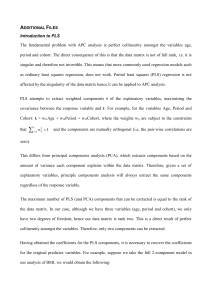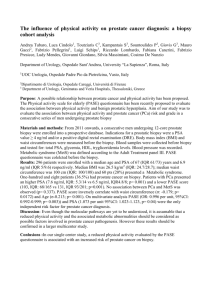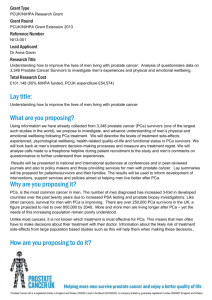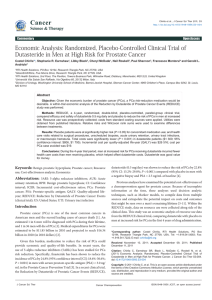CPCBN pamphlet
advertisement
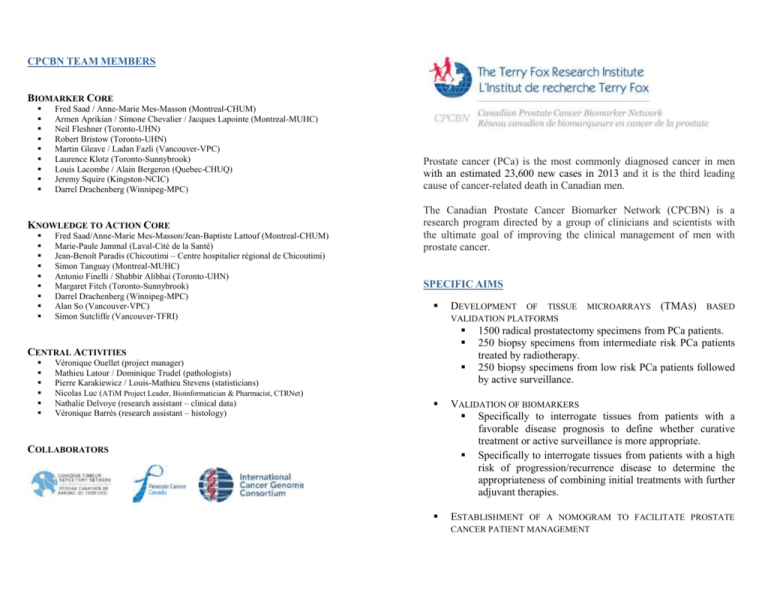
CPCBN TEAM MEMBERS BIOMARKER CORE Fred Saad / Anne-Marie Mes-Masson (Montreal-CHUM) Armen Aprikian / Simone Chevalier / Jacques Lapointe (Montreal-MUHC) Neil Fleshner (Toronto-UHN) Robert Bristow (Toronto-UHN) Martin Gleave / Ladan Fazli (Vancouver-VPC) Laurence Klotz (Toronto-Sunnybrook) Louis Lacombe / Alain Bergeron (Quebec-CHUQ) Jeremy Squire (Kingston-NCIC) Darrel Drachenberg (Winnipeg-MPC) KNOWLEDGE TO ACTION CORE Fred Saad/Anne-Marie Mes-Masson/Jean-Baptiste Lattouf (Montreal-CHUM) Marie-Paule Jammal (Laval-Cité de la Santé) Jean-Benoît Paradis (Chicoutimi – Centre hospitalier régional de Chicoutimi) Simon Tanguay (Montreal-MUHC) Antonio Finelli / Shabbir Alibhai (Toronto-UHN) Margaret Fitch (Toronto-Sunnybrook) Darrel Drachenberg (Winnipeg-MPC) Alan So (Vancouver-VPC) Simon Sutcliffe (Vancouver-TFRI) Prostate cancer (PCa) is the most commonly diagnosed cancer in men with an estimated 23,600 new cases in 2013 and it is the third leading cause of cancer-related death in Canadian men. The Canadian Prostate Cancer Biomarker Network (CPCBN) is a research program directed by a group of clinicians and scientists with the ultimate goal of improving the clinical management of men with prostate cancer. SPECIFIC AIMS VALIDATION PLATFORMS CENTRAL ACTIVITIES Véronique Ouellet (project manager) Mathieu Latour / Dominique Trudel (pathologists) Pierre Karakiewicz / Louis-Mathieu Stevens (statisticians) Nicolas Luc (ATiM Project Leader, Bioinformatician & Pharmacist, CTRNet) Nathalie Delvoye (research assistant – clinical data) Véronique Barrès (research assistant – histology) DEVELOPMENT OF TISSUE MICROARRAYS (TMAS) BASED 1500 radical prostatectomy specimens from PCa patients. 250 biopsy specimens from intermediate risk PCa patients treated by radiotherapy. 250 biopsy specimens from low risk PCa patients followed by active surveillance. VALIDATION OF BIOMARKERS Specifically to interrogate tissues from patients with a favorable disease prognosis to define whether curative treatment or active surveillance is more appropriate. Specifically to interrogate tissues from patients with a high risk of progression/recurrence disease to determine the appropriateness of combining initial treatments with further adjuvant therapies. ESTABLISHMENT OF A NOMOGRAM TO FACILITATE PROSTATE COLLABORATORS CANCER PATIENT MANAGEMENT CPCBN TISSUE MICROARRAYS PRESENTLY AVAILABLE KNOWLEDGE TO ACTION GOALS Snapshot evaluation of active surveillance uptake in Canada for the year 2010. Identification, through focus groups, of factors that influence decision-making regarding active surveillance in Canada. Promote knowledge exchange to ensure the clinical application of the study findings. Organization of a large knowledge transfer meeting regrouping all TFRI translational projects to tackle how to transfer scientific discovery to clinical practice as a means of improving health outcomes. OPTIMIZATION TMAS Tissues from prostate, breast and ovarian cancer. Mouse xenograft tissues obtained by injecting PC3, LNCaP, Du145 or 22RV1 cell lines in mice. VALIDATION TEST-COHORT TMAS* 250 radical prostatectomies from PCa patients. Initial cohort. VALIDATION LARGE COHORT TMAS* 1250 radical prostatectomies from PCa patients. Independent cohort. * VALIDATION COHORT TMA QUALITY ASSESSMENT All TMAs receive a pathological review by a trained uropathologist. Immunohistochemical and FISH analyses. Quality control performed in conjunction with CTRNet testing program. Three cores of tumor tissue, two cores of normal adjacent tissue. Multiple centres. Treatment naïve patients. Complete clinical data with follow up. Clinical data stored in ATiM (Advance Tissue Management) database. Two cores of xenografts tissue obtained from PC3, LNCaP, Du145 or 22RV1 injection in mice. HOW TO ACCESS THE CPCNB COHORT 1. Contact the project coordinator by email: Véronique Ouellet: tfri.cpcbn@gmail.com 2. Fill in the biomarker proposal and send the completed application to the project coordinator. Note that biomarkers need to have sufficient preliminary data demonstrating relevance to the objectives of the CPCBN 3. The CPCBN study committee will evaluate the proposal and TMAs will be released in a stepwise manner. 4. Importantly, all images and scoring results will have to be returned to the CPCBN, normally at the time of publication. COMING SOON RADIATION COHORT Biopsy based. 250 PCa patients, collection ongoing. ACTIVE SURVEILLANCE COHORT Biopsy based. 250 PCa patients, collection ongoing.


